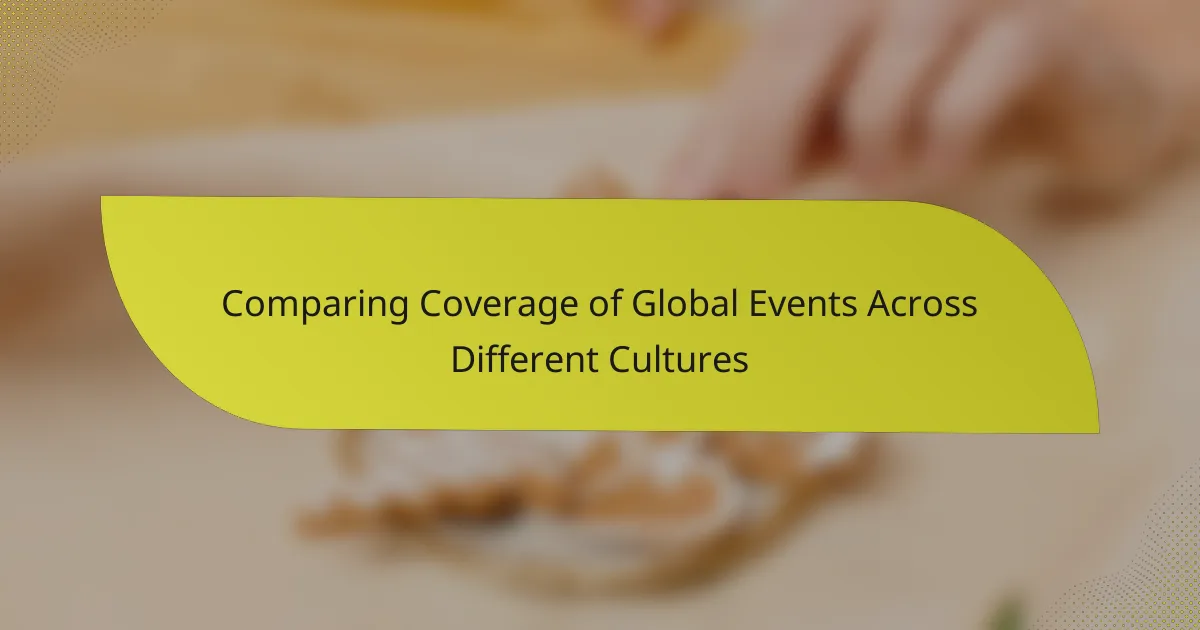Global events are interpreted through the lens of diverse cultural contexts, which shape the narratives presented by different media outlets. These interpretations are influenced by historical backgrounds, social norms, and political climates, resulting in unique coverage that highlights varying aspects of the same event. Consequently, public perceptions and reactions can differ widely, reflecting the distinct values and priorities of each culture.

How do different cultures cover global events?
Different cultures cover global events through unique perspectives shaped by historical, social, and political contexts. These differences influence the framing, emphasis, and tone of the coverage, leading to varied public perceptions and reactions.
Western media coverage
Western media, particularly in the United States and Europe, often emphasizes individualism and personal stories in their coverage of global events. This approach tends to focus on human interest angles, providing in-depth analysis and commentary.
For instance, during international crises, Western outlets may highlight personal narratives of those affected, aiming to evoke empathy and engagement from their audience. However, this can sometimes lead to a lack of broader contextual understanding of the events.
Asian media coverage
Asian media coverage often reflects a collectivist perspective, prioritizing national interests and regional implications. Countries like China and Japan may focus on how global events impact their own citizens and economies, often framing stories within a context of national pride or security.
For example, during global economic shifts, Asian media might emphasize the potential effects on local markets and industries, providing a more pragmatic view compared to the emotive storytelling common in Western media.
African media coverage
African media coverage frequently highlights issues of development, governance, and social justice. Many outlets focus on how global events affect local communities, often advocating for change and accountability.
For instance, during international climate discussions, African media may spotlight the disproportionate impact of climate change on vulnerable populations, aiming to raise awareness and drive action from both local and global leaders.
Latin American media coverage
Latin American media often combines local narratives with broader geopolitical contexts, reflecting a diverse range of voices and opinions. Coverage may emphasize social movements and political changes, showcasing how global events resonate within the region.
For example, during major international summits, Latin American outlets might focus on the implications for trade agreements and regional cooperation, highlighting both challenges and opportunities for their countries.
Middle Eastern media coverage
Middle Eastern media coverage is often influenced by political affiliations and regional conflicts, leading to varied interpretations of global events. Coverage may reflect national narratives, with some outlets promoting government perspectives while others adopt critical stances.
For instance, during international conflicts, media in the region may emphasize the historical and cultural contexts, providing insights into local sentiments and reactions that are often overlooked by Western outlets.
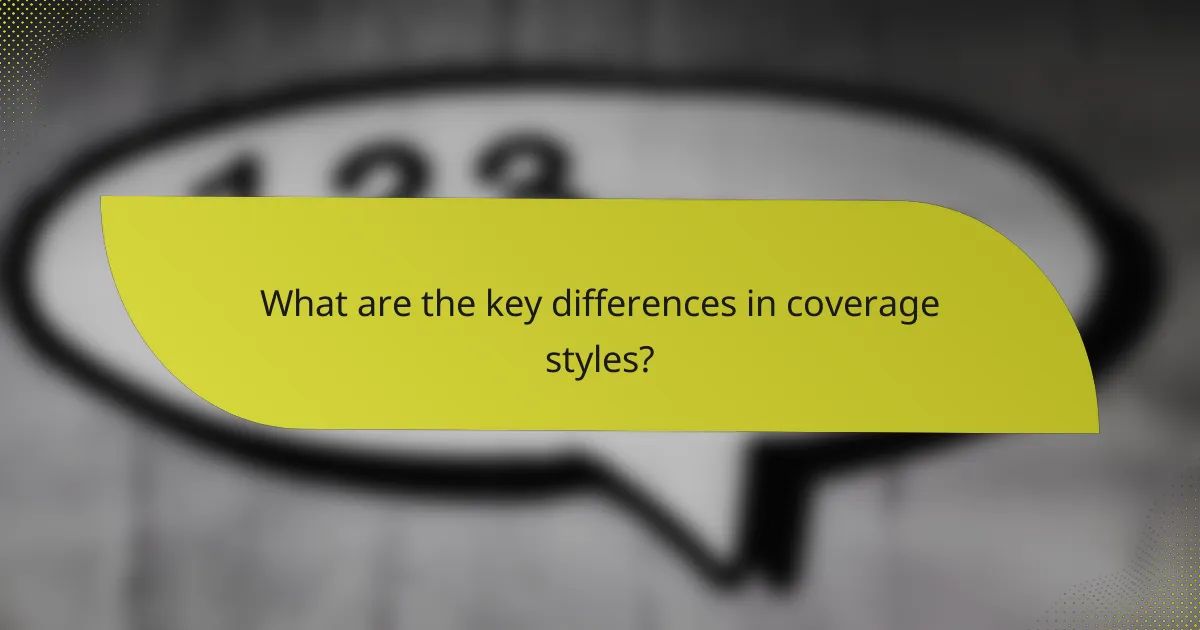
What are the key differences in coverage styles?
Coverage styles of global events vary significantly across cultures, influenced by local values, media practices, and audience expectations. These differences manifest in the focus on local versus global perspectives, the emphasis on political implications, and the use of sensationalism in reporting.
Focus on local vs. global perspectives
Media outlets often prioritize local perspectives, reflecting the interests and concerns of their immediate audience. For instance, a local news station in the U.S. might emphasize how a global event impacts its community, while a European outlet may highlight broader implications for the continent.
This local versus global focus can affect the depth of coverage. Local media may provide detailed accounts of community reactions, whereas global outlets might offer a more analytical view, discussing trends and implications across multiple regions.
Emphasis on political implications
Different cultures place varying levels of importance on the political implications of global events. In some countries, such as the U.S. and the U.K., media coverage often links international occurrences to domestic political agendas, analyzing how these events influence local policies or elections.
Conversely, in regions with less political engagement, such as some developing countries, coverage may focus more on human interest stories or economic impacts rather than political ramifications. This can lead to a more nuanced understanding of how global events resonate differently based on cultural context.
Use of sensationalism
Sensationalism in media coverage can vary widely between cultures. In some markets, such as the U.S., media may employ dramatic headlines and imagery to attract viewers, often prioritizing entertainment value over factual reporting. This can skew public perception and understanding of global events.
In contrast, other cultures may adopt a more restrained approach, focusing on factual reporting and analysis. For example, many European news outlets strive for objectivity, often avoiding sensationalist tactics to maintain credibility and trust with their audience.
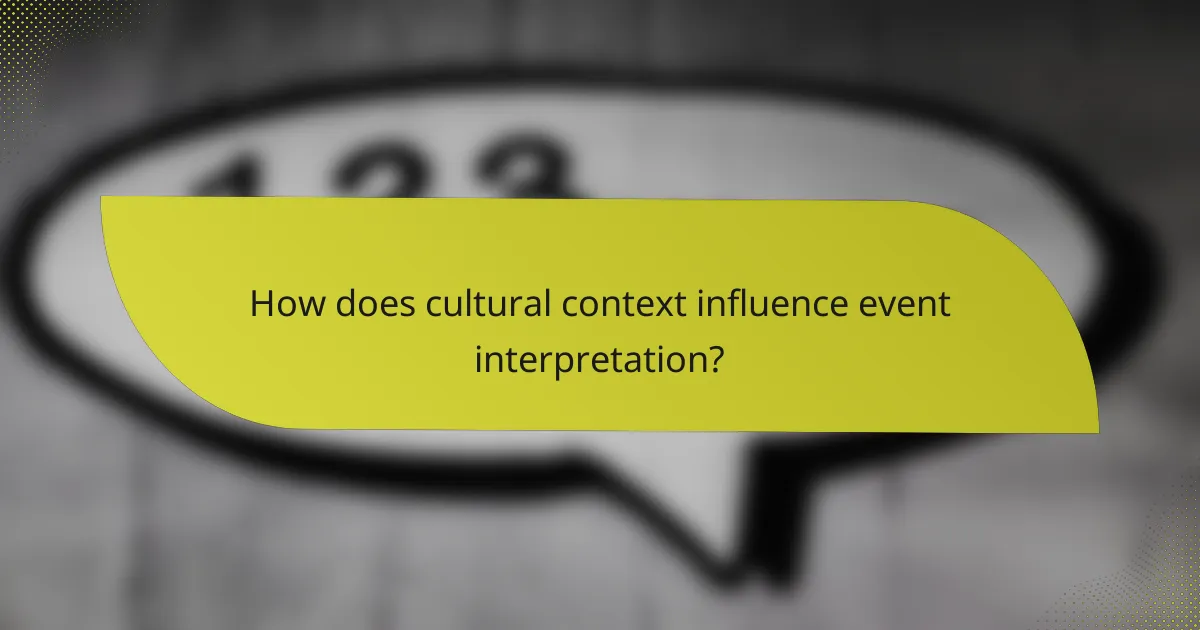
How does cultural context influence event interpretation?
Cultural context significantly shapes how events are perceived and interpreted. Factors such as historical background, social norms, and religious beliefs can lead to varying interpretations of the same event across different cultures.
Historical context
Historical context provides a framework for understanding events based on past experiences and collective memories. For instance, a country with a history of conflict may interpret a peace treaty as a critical turning point, while another nation might view it as a mere formality. Recognizing these historical narratives is essential for grasping the nuances in event coverage.
Additionally, the impact of colonialism, wars, or significant political changes can color how events are reported and understood. For example, nations with a legacy of colonial rule may focus on themes of sovereignty and self-determination when covering international events.
Social norms and values
Social norms and values dictate what is considered acceptable or important within a culture, influencing event interpretation. In cultures that prioritize community over individuality, events may be framed in terms of collective impact rather than personal stories. For example, a natural disaster might be reported with an emphasis on community resilience rather than individual loss.
Moreover, varying attitudes towards authority and governance can shape how events are perceived. In societies with high trust in government, citizens may interpret political events more positively, while in cultures with skepticism towards authority, the same events may be viewed with suspicion.
Religious influences
Religious beliefs can profoundly affect how events are interpreted, often providing moral frameworks that guide understanding. For instance, a natural disaster might be seen as a divine message or a test of faith in some cultures, while others may focus on scientific explanations and humanitarian responses.
Additionally, religious calendars and observances can influence the timing and framing of events. For example, significant events occurring during religious holidays may be interpreted through a spiritual lens, affecting public sentiment and media coverage.
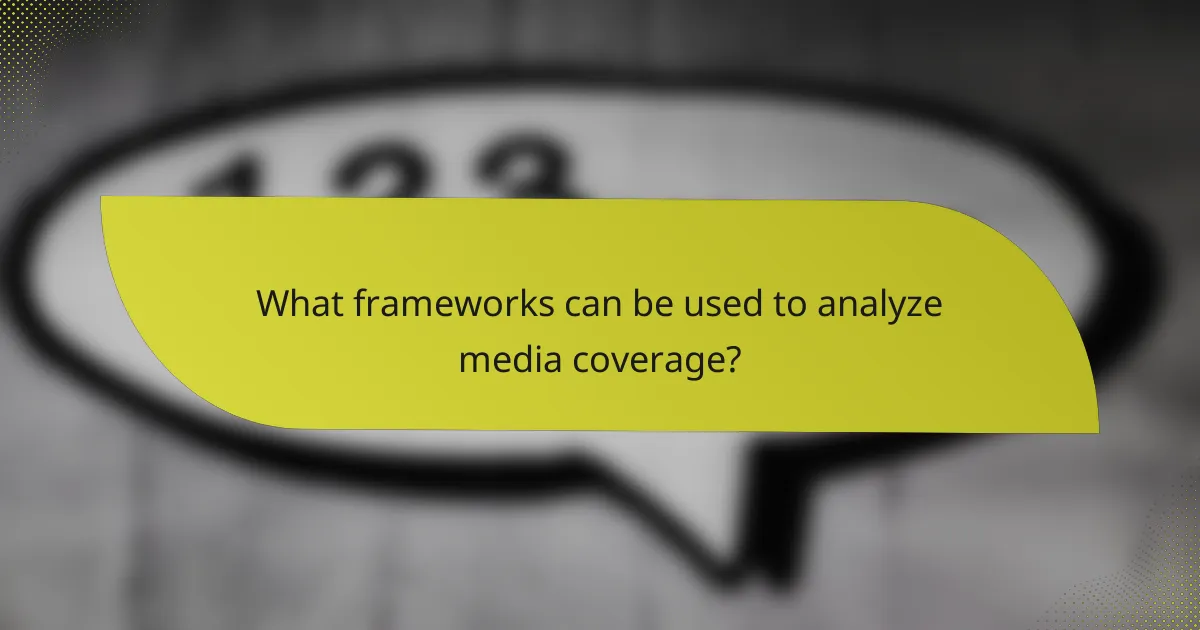
What frameworks can be used to analyze media coverage?
Several frameworks can effectively analyze media coverage, particularly in the context of global events across different cultures. Key methodologies include comparative media analysis and cultural framing theory, which provide insights into how various cultures interpret and report on the same events.
Comparative media analysis
Comparative media analysis involves examining how different media outlets report on the same global events. This method highlights variations in tone, focus, and detail, revealing cultural biases and priorities. For instance, a news story about climate change may be covered extensively in European media, while receiving minimal attention in some Asian outlets.
To conduct a comparative media analysis, select a specific event and gather reports from diverse sources across cultures. Analyze aspects such as language, imagery, and the presence of local context. This can help identify patterns and discrepancies in coverage, providing a clearer understanding of cultural perspectives.
Cultural framing theory
Cultural framing theory examines how media shapes public perception by emphasizing certain aspects of an event while downplaying others. This framework is crucial for understanding how cultural values influence the portrayal of global events. For example, a conflict may be framed as a humanitarian crisis in one culture and a political struggle in another.
When applying cultural framing theory, consider the underlying narratives that inform media coverage. Look for recurring themes, symbols, and language that reflect cultural attitudes. This analysis can reveal how different societies prioritize issues and influence public opinion, making it essential for understanding global media dynamics.
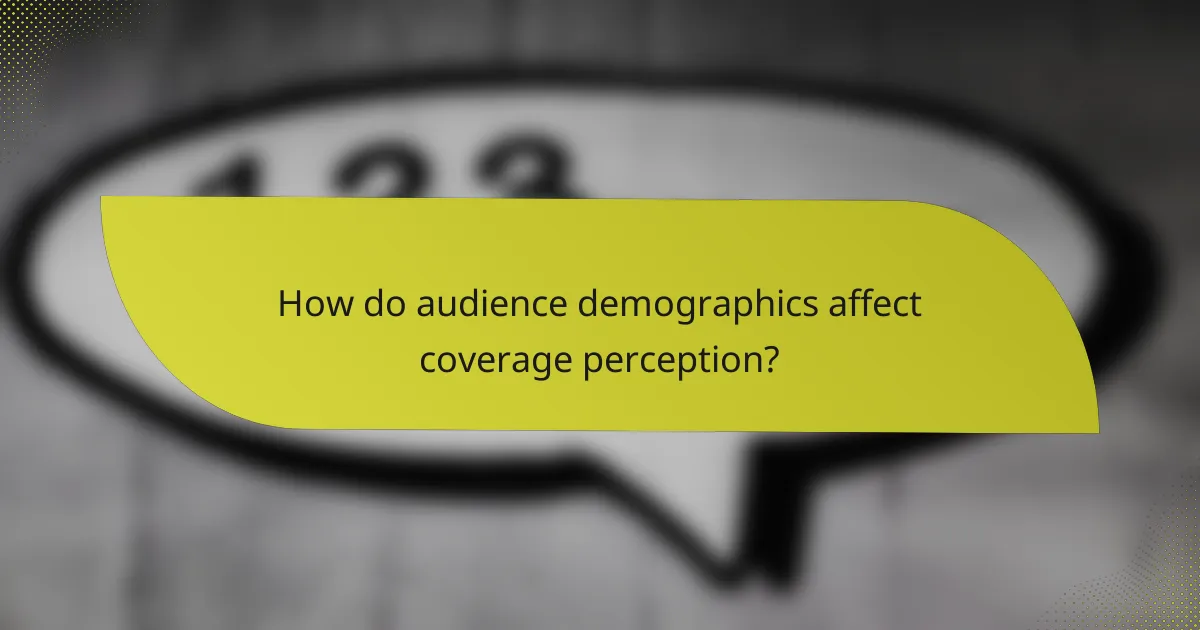
How do audience demographics affect coverage perception?
Audience demographics significantly influence how global events are perceived and reported. Factors such as age, geographic location, and socioeconomic status shape the narratives that resonate with different groups, affecting both media coverage and public interpretation.
Age-related preferences
Different age groups tend to favor distinct types of coverage based on their interests and media consumption habits. Younger audiences often prefer digital platforms and social media for real-time updates, while older demographics may lean towards traditional news outlets like television and newspapers.
This generational divide can lead to varying interpretations of the same event. For example, younger viewers might focus on social justice aspects, whereas older viewers might prioritize economic implications.
Geographic influences
Geographic location plays a crucial role in shaping coverage perception. Local news outlets often highlight events that directly impact their communities, leading to a more localized understanding of global issues. For instance, a natural disaster may receive extensive coverage in nearby regions, while distant areas may see less focus.
Additionally, cultural context can alter the framing of events. In Europe, for example, coverage of refugee crises may emphasize humanitarian aspects, while in other regions, it might focus on security concerns.
Socioeconomic factors
Socioeconomic status influences access to information and the type of coverage individuals engage with. Higher-income groups may have access to premium news services that provide in-depth analysis, while lower-income individuals might rely on free, less comprehensive sources.
This disparity can lead to different understandings of global events. For instance, wealthier audiences might prioritize economic impacts, while those from lower socioeconomic backgrounds may focus on social implications and immediate effects on their communities.

What role do social media platforms play in event coverage?
Social media platforms significantly influence how global events are covered and perceived across different cultures. They facilitate real-time sharing of information, allowing users to engage with news as it unfolds, which can shape public narratives and opinions.
Influence of Twitter on news dissemination
Twitter is a powerful tool for news dissemination due to its fast-paced nature and character limit, which encourages concise updates. Journalists and news organizations often use Twitter to break stories, share live updates, and engage with audiences directly. For example, during major events like elections or natural disasters, tweets can provide immediate insights that traditional media may take longer to report.
However, the brevity of tweets can lead to misinformation if context is lost. Users should verify information through multiple sources before sharing, especially during critical events where clarity is essential.
Facebook’s role in shaping narratives
Facebook plays a crucial role in shaping narratives around global events by allowing users to share articles, videos, and personal experiences. The platform’s algorithm prioritizes content that generates engagement, which can amplify certain perspectives while sidelining others. This can create echo chambers where users are exposed primarily to viewpoints that align with their own.
To navigate this, users should seek diverse sources of information and be mindful of the potential for bias in their news feeds. Engaging with a variety of content can provide a more balanced understanding of events and counteract the effects of algorithm-driven narratives.
